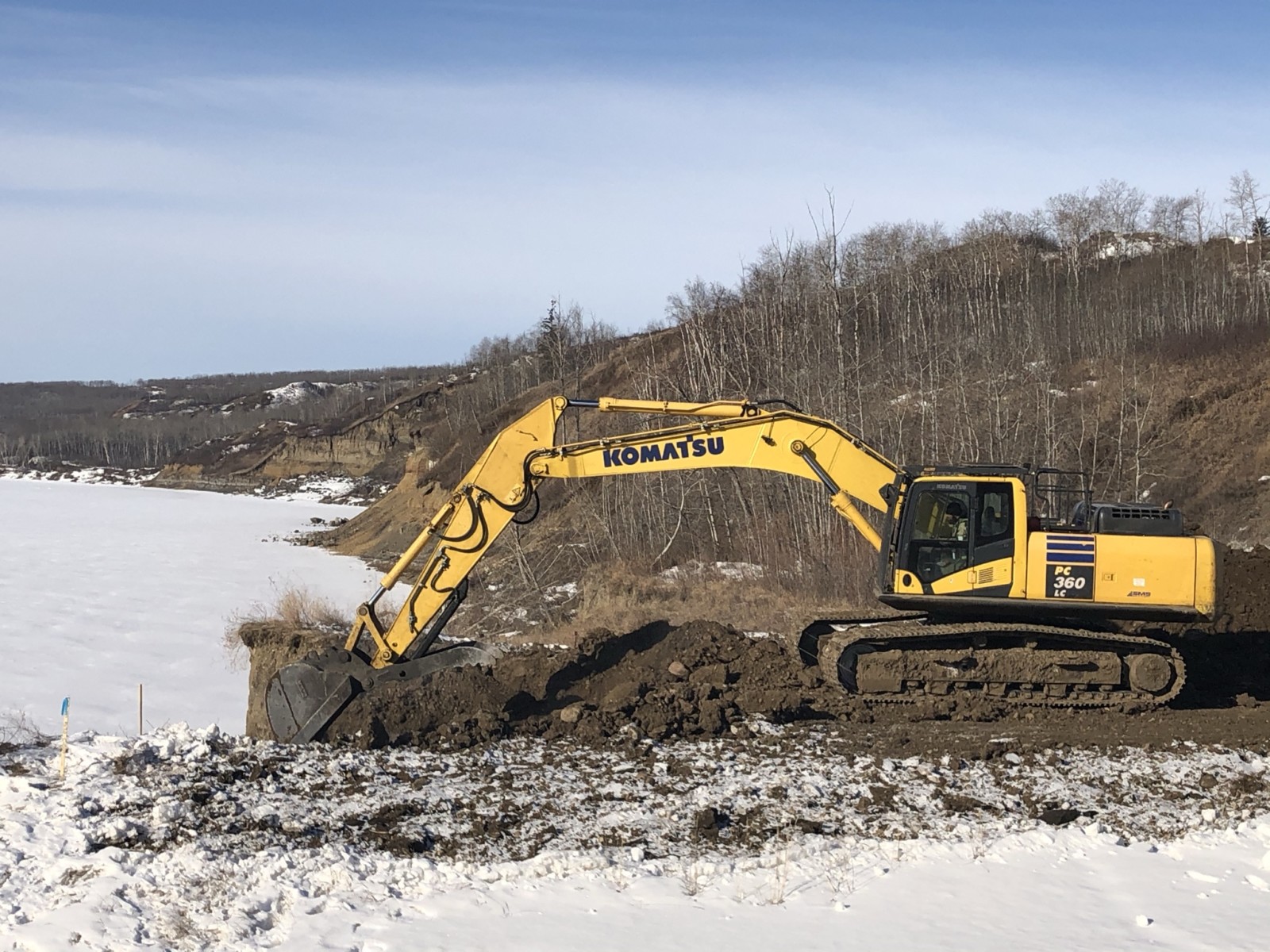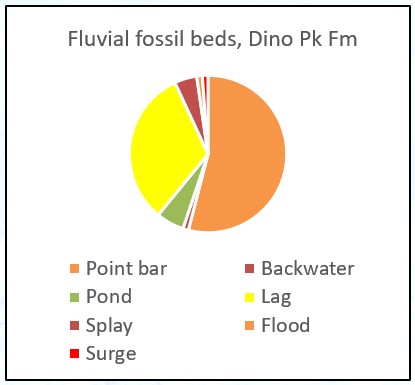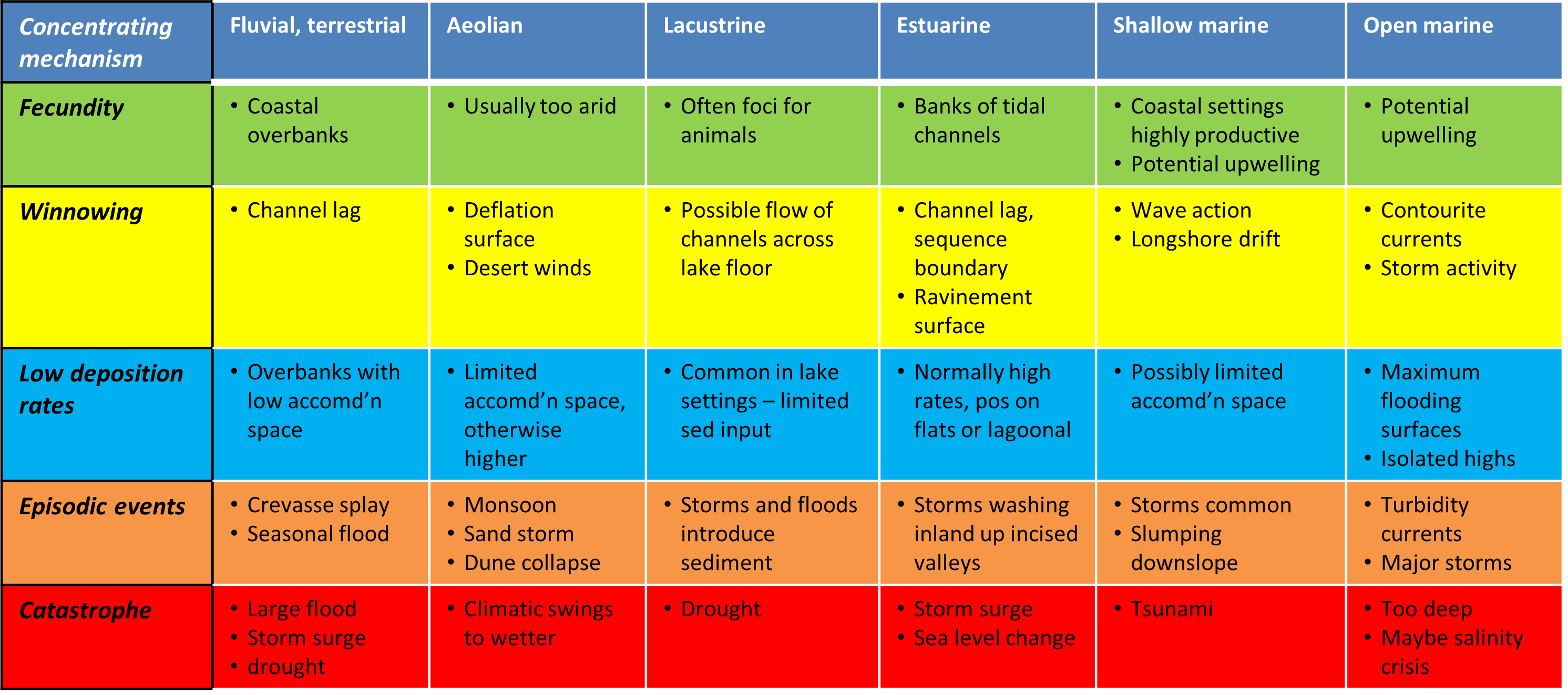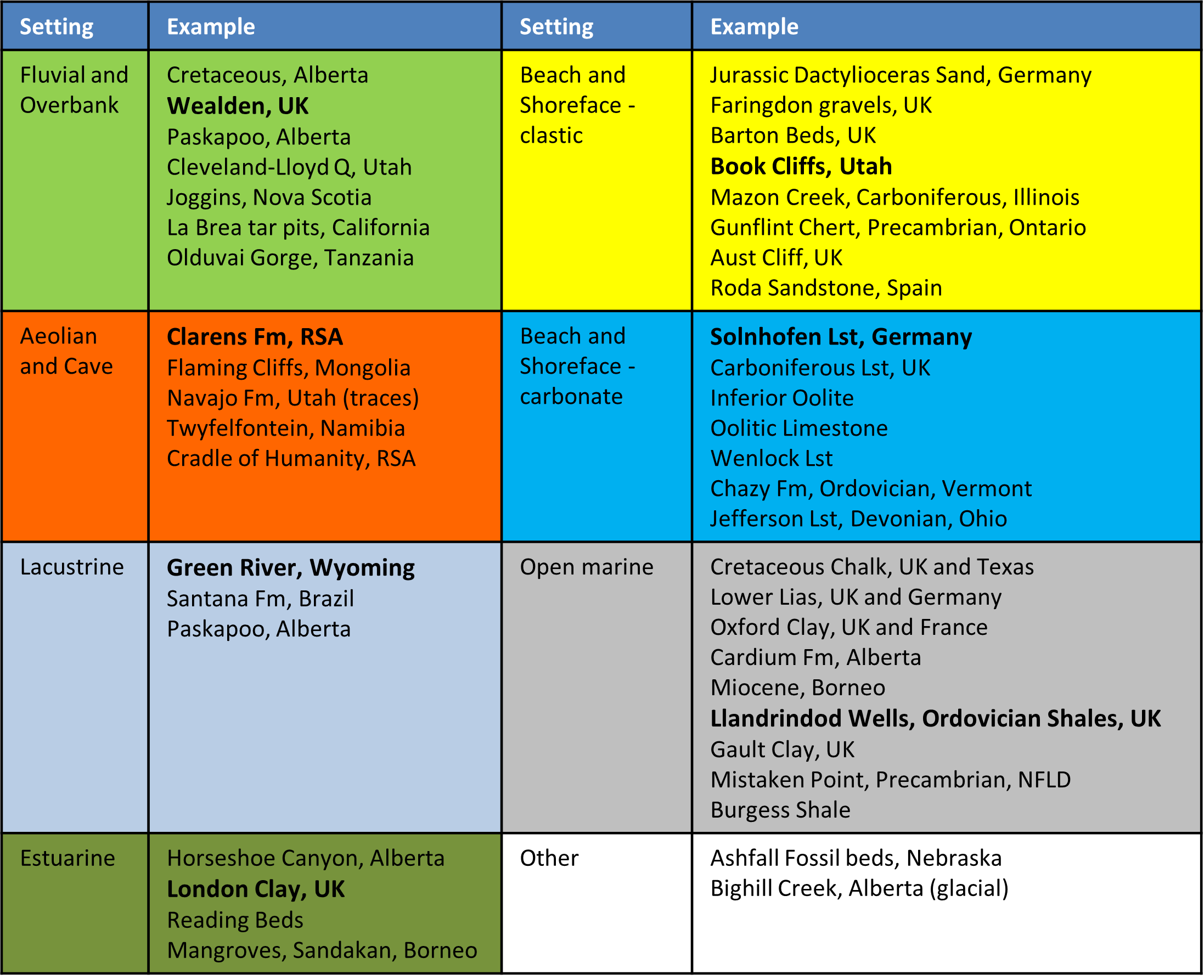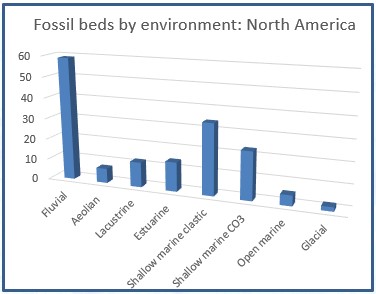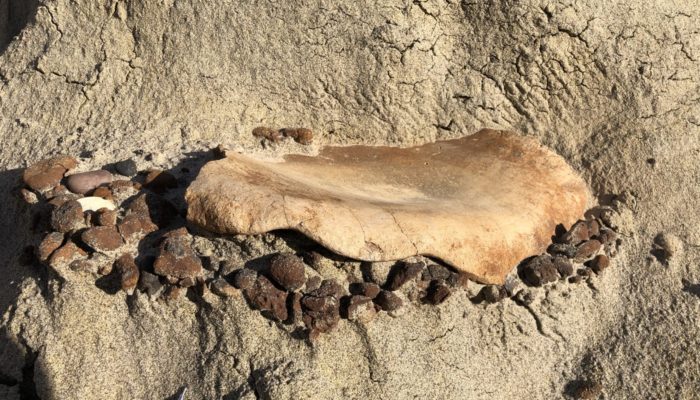
A chance to reflect
Over the last year, I have been lucky enough to spend more than two months in the field examining a variety of outcrops representing terrestrial, glacial and marine depositional settings. To protect Alberta’s fossil heritage, the law demands that all sites where excavation will be undertaken must be assessed for their paleontological potential. Should it prove likely that significant fossils may be encountered during digging, then a palaeontologist must be on site to monitor the material being excavated.
As a result, I have surveyed the locations of, and observed activity related to, bridge remediations, construction sites, pipeline trenches, a new irrigation water dam and seismic surveys. The latter meant visiting hundreds of shot point locations on foot in the badlands of central-eastern Alberta. Spending this long looking for fossils led to my musing on how fossils accumulate in the fossil record, and specifically how extraordinarily rich deposits are concentrated. Unsurprisingly, a variety of factors are at work, many of which relate to the sedimentology of the various deposits.
Finding fossils
Before we go on, a few tips on how to find fossils. Begin by reconnoitring the area and carefully observing where the fossils occur. Continue throughout the day as subtle differences in lithology may have a huge impact on their abundance. Compare fresh to weathered surfaces as this may also affect fossil distributions and preservation. Low elevation outcrops yield more fossils because less sediment is washed down slope onto the exposed surfaces, while finer grained sediment erodes rapidly, dries out and is scoured off by winds leaving fresh surfaces.

This crinoid was found by a couple who wandered off during a field trip – crinoids were not uppermost in their minds
Generally, the best lithologies in which to find fossils are mudstones, due to their fine grain size, because the fossils weather out or can be extricated more easily, and because preservation is usually excellent. Limestones also preserve fossils well but are often hard and massive, making extraction difficult, although weak acid may help. Sandstones may be rich in invertebrates but tend to be porous, allowing shell and bone material to be dissolved leaving only casts. Cementation by siderite can help to preserve detailed structures.
Some people just seem to have “the knack” or “the eye” for finding fossils. A sharp eye obviously helps, but equally important is handling fossils on a regular basis and examining them at all angles. In this way the brain is able to imprint the shapes created by the fossils so that even a partial view of an oddly oriented fossil will be discerned by the observer, firing the synapses. Finally a little luck never hurts when looking for ancient life.
Major factors affecting fossil concentrations
A key variable is obviously deposition rate, which can be very  variable depending on factors such as sediment supply, water depth, biological processes, precipitation and weathering and sequence stratigraphy. The Sadler Effect, where deposition rates fall with increasing time span, is also important. When the other factors are kept constant, fossil concentration provides a proxy for deposition rate. The concentrating mechanisms in deposits where fossils are unusually abundant can be classified into five categories:
variable depending on factors such as sediment supply, water depth, biological processes, precipitation and weathering and sequence stratigraphy. The Sadler Effect, where deposition rates fall with increasing time span, is also important. When the other factors are kept constant, fossil concentration provides a proxy for deposition rate. The concentrating mechanisms in deposits where fossils are unusually abundant can be classified into five categories:
The following sections will discuss how these preservation mechanisms operate in different depositional settings. The mechanisms are highlighted in bolded italics.
Fluvial deposits
Much of my work relating to seismic surveys has focused on Cretaceous badlands, close to Dinosaur Provincial Park, exposing Cretaceous fluvial deposits. Dinosaur remains are the most common fossils with many isolated bones as well as bone beds and microvertebrate sites. The latter are made up of the smaller vertebrate elements that are typically washed together and may include teeth, bone fragments, fish scales, claws and coprolites.
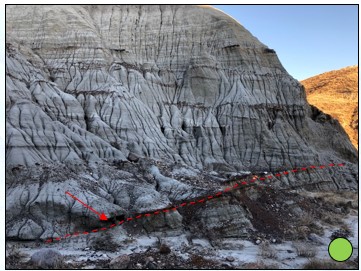
Intra channel erosion surface in point bar deposits that yielded over forty dinosaur teeth and other skeletal elements, Campanian, Alberta
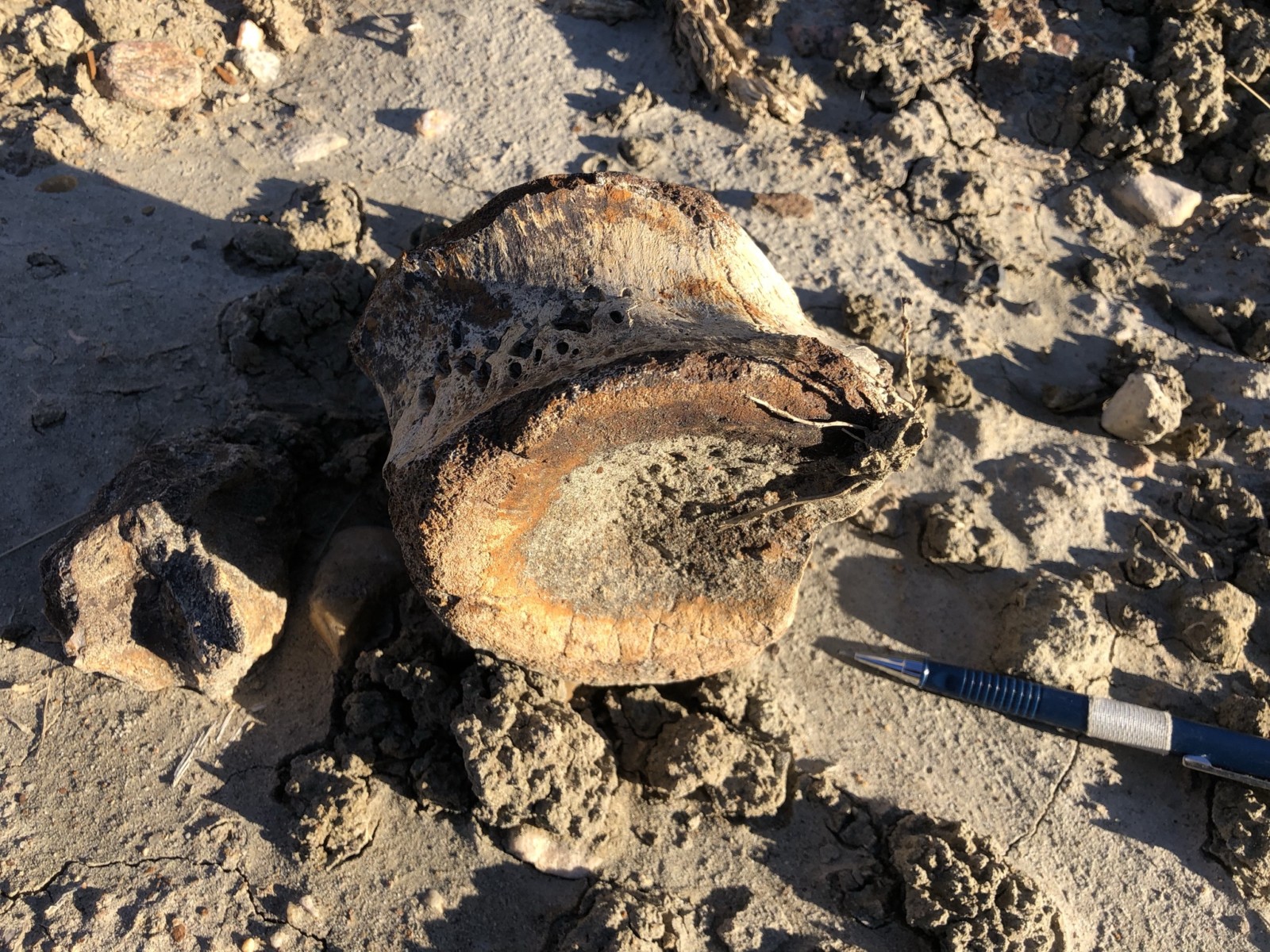
Isolated Hadrosaur vertebra recovered from the uppermost Dinosaur Park Formation, Campanian, Alberta
Many fossils were found on the inclined surfaces (lateral accretion surfaces and inclined heterolithic stratification) within point bars. Animals were probably washed into rivers from floodplains after death and their carcasses later stranded on bankside bars. These are considered as fecund localities where dinosaurs thrived. Backwaters and ponds with an abundant invertebrate fauna, in addition to microvertebrates, are interpreted to have undergone relatively slow deposition rates.
Channel lag deposits include both bones and microvertebrate fossils, which are envisaged to have been concentrated through winnowing. Some lags can be tracked for hundreds of metres. Current speed and bedload will influence what type and size of fossils are preserved. Bones are often rounded due to transport and consequent abrasion.

My daughter searching for microvertebrates in a crevasse splay deposits at Ferry Crossing in eastern Alberta
More extreme fluvial-related events may also concentrate fossils. Crevasse splays are episodic events that wash across the floodplain, typically washing together microvertebrate material. Episodic flooding horizons can be identified by large bones on a bedding plane or inclined surface, often associated with ironstone-cemented mudstone clasts. Finally, at least 24 monospecific bone beds have been identified in Dinosaur Provincial Park, to which I was able to add another two examples from my fieldwork. These are attributed to catastrophic storm surges, facilitated by giant storms and hot, convective air currents.
A total of 87 significant fossil sites were identified during monitoring on a survey close to the Park. The majority occurred on point bars, while lags made up most of the remainder. Pond deposits and extreme events were much rarer.
Aeolian, lacustrine and estuarine settings
Both body and trace fossils are decidedly uncommon in AEOLIAN deposits.
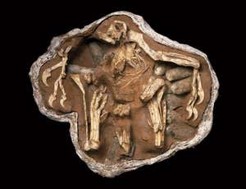
Ornithoraptor with eggs and nest, interpreted as being entombed by aeolian sands in a dust storm (Wikipedia)
The challenging environment makes life difficult. Winnowed deflation surfaces are common but fossils are rare. Dune slumps (classified as extreme events) have been recorded trapping animals beneath them, none more famous than the ornithoraptor and nest buried by sand dune collapse in the Cretaceous (Gobi) Desert of Mongolia. Episodic sand storms might also entomb animals – fieldwork while in the deserts of southwest Saudi Arabia led to the discovery of at least six camel carcasses, exposed by desert winds. These deaths may well be drought related, which could be considered as either episodic or catastrophic.
LACUSTRINE settings often feature unusual geochemistry and slow deposition rates.
Rich fossil assemblages appear most common during periods of drought (extreme), although benign (fecund) conditions can also favour common fossils, as in the Turritella Chert in the Green River Formation.
ESTUARINE deposits are particularly sensitive to changes in relative sea level. Fossils can accumulate in the resulting incised valleys on ravinement surfaces, as well as lags in tidal creeks (both winnowing). Tidal flats may be fecund, with fossils also washed together during extreme storm surges. Mangrove deposits will also accumulate at slow deposition rates or as winnowed accumulations in creeks.
Beach, reefs and shoreface deposits
Beach and shallow marine deposits are usually winnowed due to wave action. This often leads to accumulations of shelly material although the shells are usually comminuted. Diagenetic dissolution often leaves casts while remobilizing the calcium carbonate. Lag deposits are common with fish teeth and phosphatized coprolites concentrated on ravinement surfaces, while storms scour the seabed with similar winnowing effect. Many shallow marine organisms, such as oysters, have robust shells that are easily preserved and fossilized.

The stunning Atlas Medusa, a shallow marine carbonate deposit from Morocco (http://www.dalerogersammonite.com/)
Where clastic input is limited, this allows the development of shallow marine carbonates, particularly along tropical coastlines. In such fecund settings, life is typically extremely abundant, leading to many fossils, as seen in many limestone deposits. Slow deposition rates in times of limited accommodation space can facilitate the concentration of invertebrate fossils and material may slump downslope (episodic) leading to the deposition of fossiliferous, redeposited facies.
Open marine deposits
In distal settings, fossils are typically concentrated on maximum flooding surfaces, where deposition slows. Such surfaces can be picked out on logs due their radioactive signature, representing concentrated organic material. There may also be bone beds with fish fossils. Isolated highs can also lead to slow deposition, as in the Inferior Oolite in England, where multiple ammonite zones are superimposed over a few metres of stratigraphic section.
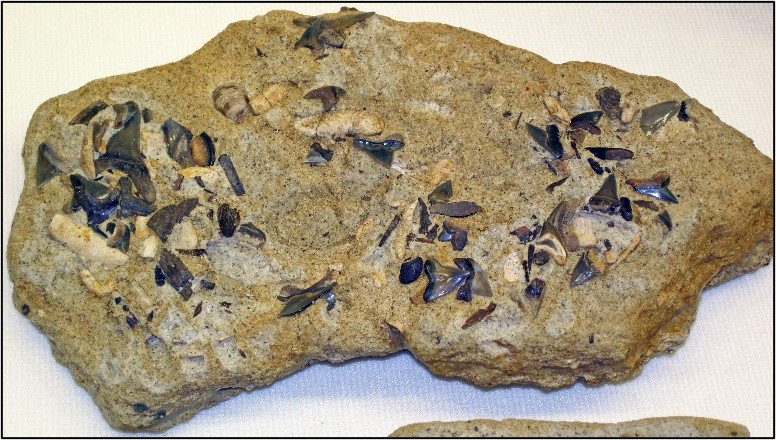
Specimen from the Niobrara Chalk showing an omission surface with abundant shark teeth preserved (photo by St. James)
Event beds (episodic) include storm deposits and turbidites, both of which may be rich in faunal remains. An example from the Miocene of eastern Borneo features centimetre thick storm beds, with hummocky cross-stratification, and hundreds of fossil crabs and other invertebrates, preserved through (diagenetic) siderite cementation.
Discussion
The table below summarizes what I consider to be the most important concentrating mechanism for each depositional setting. I have included a second table where I have classified some of the most famous, richly fossiliferous deposits in the world by dominant mechanism. These include well studied deposits of the UK such as the London Clay and Ordovician shales, as well as the Solnhofen Limestone and other lagerstatten.
I have also put together a diagram
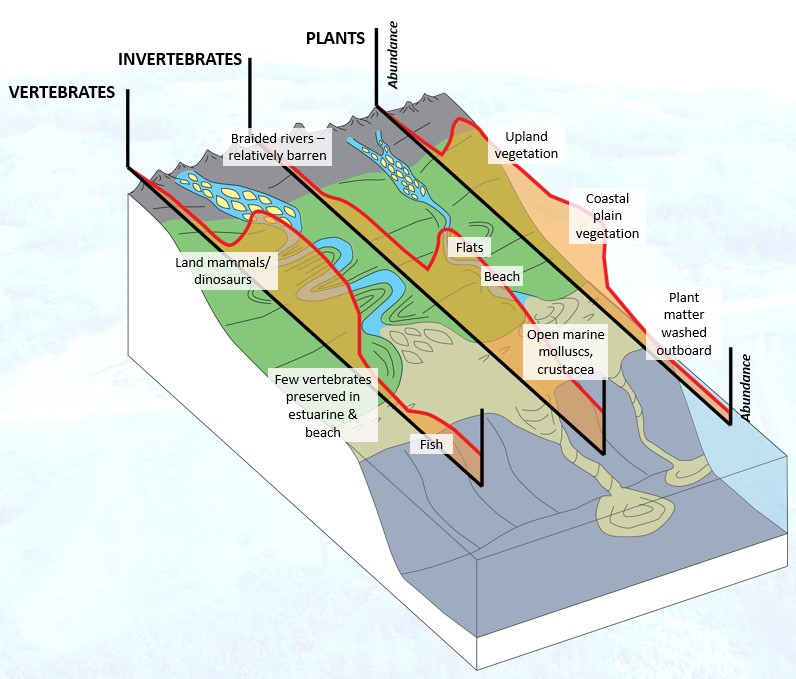
Graphical representation of where fossil abundance for main fossil groups is highest in different depositional settings
summarizing where abundant fossils (vertebrates, invertebrates and plants) are most likely to occur, moving from proximal, braided fluvial deposits out to the open ocean.
Testing the concept on real data
A dataset of 156 “extraordinary” fossil sites across North America (sourced from Wikipedia and other data) was first classified by depositional setting. The graph below shows that fluvial settings host the most sites. This is interpreted to be because:
- They are easier to locate because they host large vertebrate fossils
- Dinosaurs and large mammals are very popular and gain more funding
- Fluvial settings are more liable to catastrophic events due to potential for drought, fire, famine
- Published bone bed data shows that Cetaceous lags and floods are the most common catastrophes
The next most abundant settings are shallow marine accumulations.
When pie charts of the relative proportions of the driving mechanisms behind fossil abundance, classified by depositional setting, are assembled (see figure below), some interesting observations can be made:
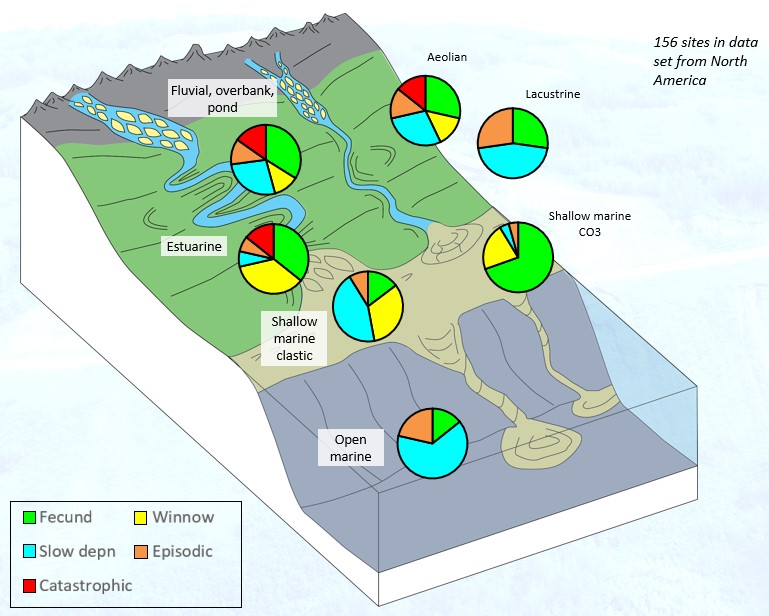
Main drivers for fossil abundance by setting (dataset of 156 extraordinary fossil sites in North America)
- The relative proportions of mechanisms are very similar for fluvial aeolian and estuarine settings, and show a balance between all five drivers
- Lacustrine settings are dominated by slow deposition, with some fecundity and droughts
- Shallow marine carbonates are mostly fecund settings
- Shallow marine clastics are dominated by slow deposition or winnowing, while open marine settings rely on slow deposition rates
Other uses for macrofossils in sedimentology
In this blog we have focused on sedimentological drivers behind fossil abundance. However, there are many other ways in which macrofossils can be used in sedimentology:
- Interpreting depositional settings – clearly the most fundamental use of fossils, and of key importance. Integration of palaeontological and sedimentological data provides a very powerful tool when reconstructing ancient environments. Trace fossils are particularly useful in this regard
- Taphonomy (fossil preservation) and implications for energy levels
- Estimating deposition rates
- Paleocurrents (and wind direction) interpolated from fossil orientation
- Leaf margin analysis and climate
- Geopetal (way up) structures preserved through diagenetic infilling
So, to summarise, every sedimentologist really needs to unlock their inner palaeontologist.

